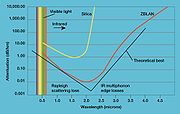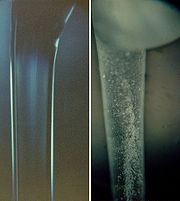
ZBLAN
Encyclopedia


Fluoride glass
Fluoride glass is a class of non-oxide optical glasses composed of fluorides of various metals. Due to their low viscosity, it is very difficult to completely avoid the occurrence of any crystallization while processing it through the glass transition...
es were accidentally discovered in 1975 by Poulain and Lucas at the University of Rennes in France, including a family of glasses ZBLAN with a composition ZrF4-BaF2-LaF3-AlF3-NaF.
ZBLAN has a broad optical transmission window extending from 0.3 micrometers in the UV to 7 micrometers in the infrared, low refractive index (1.50), a relatively low glass transition temperature (Tg) of 260 °C, low dispersion
Dispersion
Dispersion may refer to:In physics:*The dependence of wave velocity on frequency or wavelength:**Dispersion , for light waves**Dispersion **Acoustic dispersion, for sound waves...
and a low and negative dn/dT (temperature dependence of refractive index).
ZBLAN glass is the most stable fluoride glass known and is most commonly used to make into optical fiber. Recent advances by ZBLAN fiber manufacturers have demonstrated significant increases in mechanical properties (>100 kpsi or 700 MPa for 125 µm fiber) and attenuation as low as 3 dB/km at 2.6 µm. ZBLAN optical fibers are used in different applications such as spectroscopy and sensing, laser power delivery and fiber lasers and amplifiers.
The advantages of ZBLAN over other glasses, such as silica is superior infrared transmittance. Their drawbacks are fragility and sensitivity to moisture. ZBLAN glass resistance to water depends strongly on the acidity of the aqueous solution. Acidic solutions will attack it, whereas basic solutions will have no effect. Atmospheric moisture has a very limited effect on fluoride glasses in general, and fluoride glass/fibers can be used in a wide range of operating environments over extended periods of time without any material degradation.
A large variety of multicomponent fluoride glasses have been fabricated but few can be drawn into optical fiber. The fiber fabrication is similar to any glass-fiber drawing technology. All methods involve fabrication from the melt, which creates
inherent problems such as the formation of bubbles, core-clad interface irregularities, and small preform sizes. The process occurs at 310 °C in a controlled atmosphere (to minimize contamination by moisture or oxygen impurities which significantly
weaken the fiber) using a narrow heat zone compared to silica. Drawing is complicated by a small difference (only 124 °C) between the glass transition temperature and the crystallization temperature. As a result, ZBLAN fibers often contain undesired crystallites. Their concentration can be reduced by growing ZBLAN in zero gravity (see figure) which reduces convection processes.

